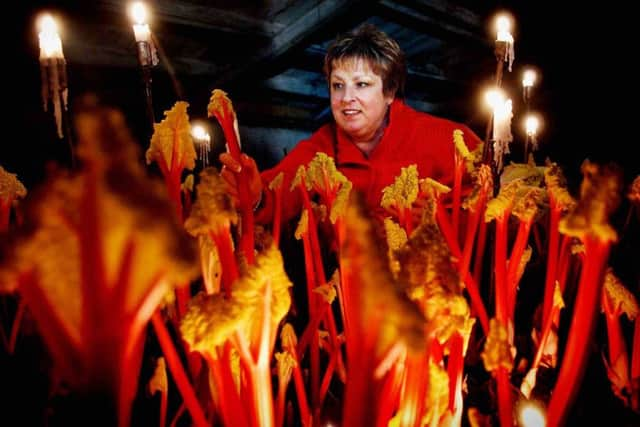Alcohol provides extra market for Yorkshire rhubarb growers
and live on Freeview channel 276
Grower Janet Oldroyd Hulme of E Oldroyd & Sons who harvests the crop at her farm in Carlton, Wakefield reports that demand is spiralling all the time for supplies of ‘Class 2’ cuts of Yorkshire Forced Rhubarb.
The trend comes at a time of good growing conditions for the crop in Yorkshire’s Rhubarb Triangle, a 9-square-mile triangle between Wakefield, Morley and Rothwell famous for producing early forced rhubarb. The area has enjoyed two strong summers and enough subsequent frost to put Oldroyds on target to at least match its 200-tonne crop in 2017.
Advertisement
Hide AdAdvertisement
Hide AdMrs Oldroyd, who supplies rhubarb to Harrogate-based Slingsby Gin, said: “The demand is huge for rhubarb at the moment, certainly for going into drinks like gins, vodka and liqueurs - it’s going through the roof. It’s in these tasting drinks and in cocktails in London where it’s really taking off but we have winemakers and smaller craft beer brewers come in for it too.


“It’s for Class 2 rhubarb which is thinner or looks damaged that is huge, something we don’t set out to produce but even by taking great care of the crops as we do, you are still going to get a supply of. It all helps to make the job pay.”
Oldroyds produce rhubarb for Sainsbury’s and some of their premium crop goes to top restaurants such as Heston Blumenthal’s restaurant in London’s exclusive Knightsbridge district.
Forced Yorkshire rhubarb grows in darkness and is harvested by candlelight so the remainder of the crop is not disturbed or affected by the light.
Advertisement
Hide AdAdvertisement
Hide AdIt begins life as cuttings taken from a mature crown two years before harvesting and when it is strong enough, the cuttings are planted in fields to mature, ready for the forcing shed.


Mrs Oldroyd has previously told of fears that a changing climate, with warmer temperatures, threatens rhubarb production in the region’s famed growing area, but she said that recent weather conditions had helped deliver what she expects will be a second strong harvest season in a row.
“The crops look very good this year,” she said. “We’ve not had overly high temperatures for the past two summers and the rain helps the roots store energy. Then we need frosts to convert the carbohydrates into glucose which gives it that sweetness.
“Last year produced the best yields we’ve had in quite a number of years but this year’s forcing roots have had two good summers outside so I’m expecting yields will be better this year.”
Advertisement
Hide AdAdvertisement
Hide AdMrs Oldroyd’s farm is currently in the midst of its busiest week of the year. Harvesting has begun in earnest and she is preparing to host tours of the forcing sheds as part of next month’s Festival of Food, Drink & Rhubarb co-ordinated by Wakefield Council. The exposure the festival brings and the use of rhubarb in alcoholic drinks is a win-win, she said.
“It puts the word rhubarb in people’s minds and it pushes sales in supermarkets of the product itself,” Mr Oldroyd said.
Wakefield’s Festival of Food, Drink & Rhubarb runs between Friday, February 23 and Sunday, February 25, and features food and drink stalls selling Yorkshire produce, activities for young children and families, street entertainment and live cookery demonstrations.